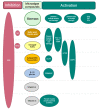Microalgae Produce Antioxidant Molecules with Potential Preventive Effects on Mitochondrial Functions and Skeletal Muscular Oxidative Stress
- PMID: 37237915
- PMCID: PMC10215861
- DOI: 10.3390/antiox12051050
Microalgae Produce Antioxidant Molecules with Potential Preventive Effects on Mitochondrial Functions and Skeletal Muscular Oxidative Stress
Abstract
In recent years, microalgae have become a source of molecules for a healthy life. Their composition of carbohydrates, peptides, lipids, vitamins and carotenoids makes them a promising new source of antioxidant molecules. Skeletal muscle is a tissue that requires constant remodeling via protein turnover, and its regular functioning consumes energy in the form of adenosine triphosphate (ATP), which is produced by mitochondria. Under conditions of traumatic exercise or muscular diseases, a high production of reactive oxygen species (ROS) at the origin of oxidative stress (OS) will lead to inflammation and muscle atrophy, with life-long consequences. In this review, we describe the potential antioxidant effects of microalgae and their biomolecules on mitochondrial functions and skeletal muscular oxidative stress during exercises or in musculoskeletal diseases, as in sarcopenia, chronic obstructive pulmonary disease (COPD) and Duchenne muscular dystrophy (DMD), through the increase in and regulation of antioxidant pathways and protein synthesis.
Keywords: antioxidant molecules; exercise; microalgae; mitochondrial function; musculoskeletal diseases; oxidative stress; redox homeostasis.
Conflict of interest statement
The authors declare no conflict of interest.
Figures




References
-
- Pal J., Shukla B., Maurya A., Verma H., Pandey G., Amitha A. A Review on Role of Fish in Human Nutrition with Special Emphasis to Essential Fatty Acid. Int. J. Fish. Aquat. Stud. 2018;6:427–430.
Publication types
Grants and funding
LinkOut - more resources
Full Text Sources

